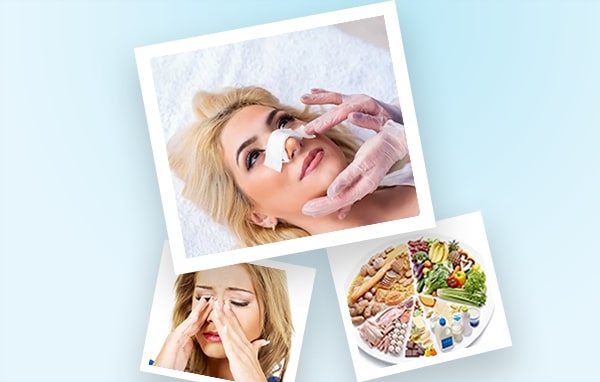Rhinoplasty: Post-Operative Precautions
Maintaining Optimal Hygiene After Rhinoplasty?
After rhinoplasty, impeccable hygiene is crucial for a swift, complication-free recovery. Follow your plastic surgeon's precise instructions for nasal cleansing, which may involve using a gentle saline solution to rinse your nostrils gently. Avoid forceful actions or inserting objects into your nose. Meticulous oral hygiene is also important; brush your teeth carefully to prevent infection. Remember to regularly change compresses used to absorb any minor bleeding. For optimal rhinoplasty results, meticulously follow your surgeon's instructions regarding topical products and medications. This helps maintain optimal hygiene and maximizes the benefits of your procedure. Don't neglect these simple yet crucial steps for complete healing.
Managing Pain and Medication After Rhinoplasty?
For smooth recovery, effective pain and medication management after rhinoplasty is vital. The first few days may be uncomfortable, but your surgeon will prescribe analgesics for relief. For effective pain relief, strictly adhere to dosage and scheduling. Don't wait for pain to intensify before taking medication; regular use prevents discomfort. If concerned about side effects or persistent pain despite medication, contact your surgeon. Open communication with the medical team allows for adjustment of your pain management plan, ensuring optimal comfort during recovery.
EXPRESS QUOTE
Need more information?
Your health, our priority.
Request your free quote
Ensuring Effective Medical Follow-up After Rhinoplasty?
Optimal rhinoplasty recovery requires rigorous medical follow-up. Schedule regular appointments with your plastic surgeon to monitor progress and ensure everything proceeds as planned. Use these visits to openly express concerns and ask questions. Medical follow-up extends beyond consultations; it involves diligently following your surgeon's personalized advice. Adhere to post-operative care recommendations, adjust your routine based on specific advice, and report any changes or discomfort. Transparent communication with your medical team ensures optimal follow-up and peace of mind during your post-rhinoplasty recovery.
Diet for Optimal Rhinoplasty Recovery?
Proper nutrition plays a vital role in post-rhinoplasty recovery. Prioritize nutrient-rich foods like fruits, vegetables, and lean proteins to promote healing and strengthen the immune system. Stay well-hydrated by drinking plenty of water to support the healing process. Consider dietary choices to ensure smooth recovery and a return to normal eating. Avoid very salty foods (they can cause water retention) and reduce spicy foods to prevent irritation. Opt for light, easy-to-chew meals, especially in the first few days. Following these nutritional recommendations creates a favorable environment for gentle healing and optimal recovery.
Rest and Risk Avoidance After Rhinoplasty?
Promote complication-free rhinoplasty recovery by giving your body the necessary time to heal. Limit strenuous physical activity, especially anything that could injure your nose. Rest and allow your immune system to focus on recovery. Avoid bending over excessively and be mindful of your surroundings to prevent unnecessary contact with your nose. Remember the importance of sleep for smooth post-rhinoplasty recovery; it's crucial for the healing process. These simple precautions minimize potential risks and promote peaceful, efficient recovery.
Managing Swelling and Bruising After Rhinoplasty?
Manage post-rhinoplasty swelling and bruising carefully. To mitigate swelling, keep your head elevated as much as possible, even during sleep. Apply gentle cold compresses to reduce swelling. Bruising around the eyes is common after rhinoplasty; it will gradually subside, but discreet makeup can help during healing. Follow your surgeon's instructions regarding anti-inflammatories and avoid anything that increases bleeding risk. Combining these tips with adequate rest helps reduce swelling and bruising, promoting smooth healing and optimal results.
Detecting and Treating Post-Rhinoplasty Infection Signs?
For successful rhinoplasty recovery, know how to detect and treat infection signs. Watch for unusual changes like sudden increased pain, excessive swelling, significant redness, or pus at the surgical site. Fever or flu-like symptoms could also indicate infection. Immediately contact your cosmetic surgeon if you notice any of these signs. Avoid self-treating an infection and follow medical advice for efficient management. Prompt action reduces risks and promotes successful healing, ensuring the success of your rhinoplasty.
A Smooth Return to Daily Life After Rhinoplasty?
Transition back to daily life after rhinoplasty consciously and gradually. Take your time resuming activities, starting with light tasks and avoiding excessive pressure on your nose. Take regular breaks, especially if your work requires prolonged sitting. Fatigue is normal in the initial days; listen to your body and rest. During recovery, adhere to your surgeon's recommendations regarding physical activity. Avoid strenuous exercise and gradually reintegrate into a normal routine to maximize recovery. This promotes physical well-being and optimal recovery, allowing you to confidently and serenely resume your daily life.
